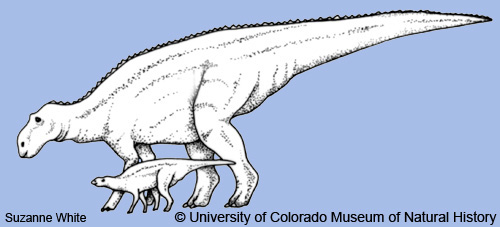

This tiny tooth came from a baby hadrosaur of the species Edmontosaurus annectens. Although this tooth is small enough for an ant to carry, Edmontosaurus was one of the largest hadrosaurs--an adult could reach up to 43 feet (13 meters) long and 4.4 tons (4 metric tons)!
Edmontosaurus was an herbivore that prefered coastal plains, like those in which the Lance Formation of Wyoming was desposited. This baby hadrosaur lived about 65 million years ago, towards the end of the Cretaceous. Hadrosaurs probably lived in migratory groups, and were one of the most common large herbivores of the Cretaceous.

The Lance Formation has produced many important fossils, ranging from tiny microfossils like those collected by harvester ants to fully articulated dinosaur skeletons. It was deposited by streams on a coastal plain stretching along the shallow interior sea of the Western Interior Seaway, which cut North America in half. Dinosaurs, reptiles, fish, amphibians, birds, and small mammals lived in a wet subtropical climate very different from today's dry seasonal climate.
Read about a rare mummified specimen of Edmontosaurus at Rare mummified dinosaur uncovered: Duckbilled Edmontosaurus covered by fossilized skin that is as hard as iron (MSNBC).
Learn more about the Lance Formation with Passport-In-Time Microvertebrate Fossil Project at the University of Wyoming Geological Museum: Late Cretaceous Paleontological Resources in the Public Eye.